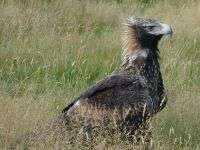The big birds came to Tassie by sea, scientists find

Researchers have found that the Tasmanian sub-species of Australia's largest bird of prey, the wedge-tailed eagle, probably flew to the island in the past 100-plus years and did not develop separately when Tasmania was cut off from the mainland.
The findings, published in The Proceedings of The Royal Society B, were conducted by scientists from the University of Tasmania, the Department of Primary Industries, Parks, Water and Environment, the University of Adelaide, Flinders University and Hydro Tasmania.
Dr Chris Burridge from the UTAS School of Zoology said the researchers demonstrated that the endangered Tasmanian wedge-tailed eagle (Aquila audax fleayi) was not 'life-boated' on Tasmania by sea-level rise, but instead was recently established by individuals that flew across Bass Strait.
"Populations on continental islands such as Tasmania are often distinguishable from mainland relatives in features such as body size, appearance or behaviour," he said.
"In the case of the wedge-tailed eagle, Tasmanian adults are darker in colour, with larger bodies and roost only in trees.
"It is commonly assumed that such differences developed during isolation caused by sea-level rise after the Last Glacial Maximum 18,000 years ago but we've found the current birds' ancestors colonised Tasmania by traversing a marine barrier."
The scientists genetically tested 224 individual birds – 49 from the mainland and 175 from Tasmania.
They included existing museum specimens, captive individuals, shed feathers and a Tasmanian Government frozen collection of deceased individuals collected between 1996 and 2012.
The scientists measured levels of genetic variation between the Tasmanian and mainland birds with the expectation that the Tasmanian population would exhibit lower variation.
Dr Burridge said the scientists concluded that the Tasmanian population of wedge-tailed eagle became isolated very recently from the mainland population, and certainly not as long ago as the flooding of Bass Strait 13,000 years ago.
"In addition, a vagrant wedge-tailed eagle has recorded on King Island in Reg Green's book Birds of Tasmania," he said.
"If this is correct it provides evidence of marine dispersal over short time scales. Individuals on Curtis and Rodondo Islands in Bass Strait are also likely examples."
The fact that the Tasmanian Aborigines also had a name for the bird, Nairana, suggests that translocation by Europeans is unlikely but there is some doubt as to whether this name was ascribed specifically to the wedge-tailed eagle or to other raptors as well.
Unfortunately A. audax fleayi is a threatened sub-species, and the scientists' report emphasised lower genetic variation relative to the mainland subspecies, A. audax audax, and the possibility that it is suffering from inbreeding depression.
More information: View the full paper: rspb.royalsocietypublishing.or … 89-b3d2-ba83a2dc7b86
Journal information: Proceedings of the Royal Society B
Provided by University of Tasmania



















